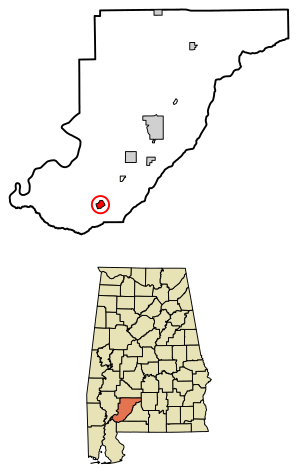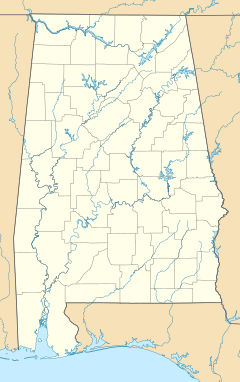Uriah, Alabama facts for kids
Quick facts for kids
Uriah, Alabama
|
|
|---|---|

Location of Uriah in Monroe County, Alabama.
|
|
| Country | United States |
| State | Alabama |
| Counties | Monroe |
| Area | |
| • Total | 1.61 sq mi (4.16 km2) |
| • Land | 1.61 sq mi (4.16 km2) |
| • Water | 0.00 sq mi (0.00 km2) |
| Elevation | 351 ft (107 m) |
| Population
(2020)
|
|
| • Total | 263 |
| • Density | 163.76/sq mi (63.22/km2) |
| Time zone | UTC-6 (CST) |
| ZIP code |
36480
|
| Area code(s) | 251 |
| GNIS ID | 153822 |
| FIPS code | 01-78120 |
Uriah (pronounced "you-rye") is a small community in Monroe County, Alabama. It is called a census-designated place because it's a group of people living together that the government counts for the census, but it's not officially a city or town. Uriah is located where two main roads, State Route 21 and State Route 59, meet. In 2020, about 263 people lived there.
Contents
Population in Uriah
This section shows how many people have lived in Uriah over the years.
| Historical population | |||
|---|---|---|---|
| Census | Pop. | %± | |
| 2010 | 294 | — | |
| 2020 | 263 | −10.5% | |
| U.S. Decennial Census | |||
History of Uriah
The Uriah area began to be settled around the 1870s. At that time, new settlers, including European Americans and people of mixed heritage, moved into the region. They worked on clearing the land, which was full of tall, old trees, to create farms.
Uriah was first known as Maros when it was covered in these huge, untouched forests. The first three families to own land between Jeddo Road (in Uriah) and the city limits of Atmore were the Hollingers, Dees, and Lomaxes. Today, Uriah is still a rural area, meaning it's mostly countryside. Most people living there work in farming or in the timber industry, which involves cutting down trees for wood.
Education in Uriah
The local school in Uriah is called J.U. Blacksher School. It was named after James Uriah Blacksher, who was one of the people who helped start the community. This school teaches students from kindergarten all the way up to 12th grade (high school).
J.U. Blacksher School first opened in 1924, and its first class graduated in 1925. The original school building was a big white wooden structure with an open-air garden and even a goldfish pond in the middle.
Sadly, the main school building burned down in January 1950. Only the gym, cafeteria, and vocational buildings were left. For about two and a half years, students had to go to school in temporary places like the Masonic Lodge and the CCC Camp at Little River State Park.
In the fall of 1951, the school was rebuilt in its current spot. Two new brick buildings were constructed for the elementary and high school students. Later, in 1972, a new cafeteria was finished, and in the fall of 1975, a new gym was completed.
More improvements came in the spring of 2001. An addition with eight new classrooms was built at the back of the campus. The main office for the school administration was also updated and made larger. The football stadium got new bleachers (seats for fans) and a press box. For the first time, lights were put up on the baseball field so games could be played at night. In 2008, another new section was added to the elementary school, providing ten more classrooms.
Culture in Uriah
Uriah hosts a yearly event called The Cotton Patch Festival. This festival is a chance for people to show off different talents, such as music or performances, and display various arts and crafts they have made.
Notable People from Uriah
- Carl Madison, a well-known former American football coach.
- Lambert C. Mims, who served four terms as a public works commissioner and was also a former mayor of Mobile. A public works commissioner helps manage things like roads and public buildings, and a mayor is the leader of a city.
See also
 In Spanish: Uriah (Alabama) para niños
In Spanish: Uriah (Alabama) para niños



